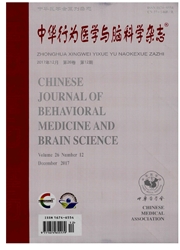

 中文摘要:
中文摘要:
目的 探讨抑郁症患者识别正性情绪时边缘环路效能连接情况,并以此探究抑郁症患者情绪加工异常的可能机制.方法 本研究对18例抑郁症患者及18例相匹配的健康对照者进行脑磁图扫描,选取喜悦表情刺激下的脑磁信号,选取眶额回(Orbitalfrontal cortex,OFC)、前扣带回(Anterior cingulated cortex,ACC)、杏仁核(Amygdala,AMYG)、海马(Hippocampus,Hipp)、脑岛(Insula,InSu)五个脑区作为感兴趣区,通过格兰杰因果模型(Granger causal model,GCM)计算出各感兴趣脑区间的效能连接值,非参数置换检验比较抑郁症患者组与健康对照组感兴趣脑区间效能连接值.结果 抑郁症患者各感兴趣脑区间的效能连接值与健康对照者相比较,经过FDR(False discovery rate)校正结果如下:ACC到AMYG效能连接下降(P=0.0052),OFC到AMYG效能连接下降(P=0.0046),Hippoeampus到ACC效能连接下降(P=0.0016),ACC到Hippocampus效能连接下降(P=0.0042).结论 抑郁症患者识别正性情绪时,边缘脑区之间的交互作用减弱,提示对正性刺激处理能力下降,在一定程度上提示抑郁症患者正性刺激处理异常神经机制.
 英文摘要:
英文摘要:
Objective To investigate the effective connectivity of limbic circuit in patients with major depressive disorder when they recognized dynamic positive face expressions,aiming to discuss the possible mechanism of emotion processing in depressed patients.Methods Eighteen depressive patients and eighteen well-matched healthy control volunteers participated in the experiment.All subjects were asked to recognize the emotion face during the magnetoencephalograph (MEG) scanning.The regions of interested (ROI) brain areas included the orbital frontal cortex (OFC),the anterior cingulated cortex (ACC),the amygdala (AMYG),the hippocampus and the insula.The MEG data were preprocessed by the SPM8 software and further analyzed by the Granger casual model (GCM).The non-parameter permutation was used to compare the value of effective connectivity between the healthy controls and the depressed patients.Results Compared with healthy controls,the effective connectivity from the ACC to the AMYG (P=0.0052),from the OFC to the AMYG(P=0.0046),from the Hippocampus to the ACC (P=0.0016),and from the ACC to the Hippocampus (P=0.0042)was significantly reduced in depressed patients.Conclusion The depressed patients display decreased interaction of the limbic circuit during the happy facial emotion processing,indicating that the depressed patients are unable to deal with the positive stimuli,and to certain extent,explaining the abnormal neuropathophysiological mechanism of positive stimuli in MDD.
 同期刊论文项目
同期刊论文项目
 同项目期刊论文
同项目期刊论文
 期刊信息
期刊信息
